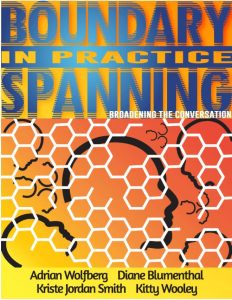 This book is an introduction to Kitty Wooley’s “Senior Fellows” initiative to develop and maintain an ongoing network of public servants (loosely defined) who are willing and able to work across organizational and functional lines to improve both public services and the conditions under which they are provided.
This book is an introduction to Kitty Wooley’s “Senior Fellows” initiative to develop and maintain an ongoing network of public servants (loosely defined) who are willing and able to work across organizational and functional lines to improve both public services and the conditions under which they are provided.
If you’re really interested in developing cross-functional working groups or styles, go to the source: https://seniorfellowsandfriends.org/unfettered-boundary-spanning/. If that doesn’t work, visit Decision Integration LLC at https://decisionintegration.com/resources-2/addl-resources/. (The book is published under a Creative Commons license, so it’s not for sale anywhere and we can give it to you).
Kitty’s LinkedIn handle is just her first name: truly a world-class networker! But she would be the first to say that this is not all about her. She does provide an introduction to the need for, and the concept of, setting up a wide informal network, with several thought-provoking scenarios, and I can certainly attest to the fact that these difficulties are by no means confined to government organizations. She also provides a summary and call to action at the end of the book.
The bulk of the book is a framework provided by Adam Wolfberg, based on initial observations of an employee engagement program at the Defense Intelligence Agency (DIA) and his subsequent analysis of what worked there and in other situations. It is well formulated, and an over-summarization here would not do it justice, but many insights are powerful enough to stand on their own even for those who choose not to dive into it further.
- Organizational boundaries may be physical (tangible) or entirely based on a mindset, but those latter ones are real boundaries nonetheless, and you’re not likely to breach them by running at them head-first. It’s not magic, but you do have to know how to use the tools and find the gaps. Boundaries aren’t all bad, as they serve to focus competencies and efforts, but they also lend themselves to over-control by insecure managers or to sharp political practices by manipulative managers.
- Breaking through a boundary to achieve new behaviors simply results in establishing new boundaries around that behavior.
- The tools for achieving and managing collaboration are much the same as those for managing change: accepting it as a major initiative to be resourced and managed; personal involvement of top leadership; empowering and providing cover fro those who are doing the boundary-crossing; employing integrated teams from all sides (vs. sending out missionaries to promote your point of view in “their” territory); and finding motivational tools to encourage the organization to seek out collaboration rather than the usual reaction of trying to stamp it out.
- It’a not a “one size fits all” solution. Each boundary issue needs to be detected and characterized, then an appropriate boundary spanner agent needs to be selected who can create an entry point, build a team approach, and chisel out a workable “new boundary”.
- While these are all “people” activities, the traditional managers in the rest of the organization need feedback in the form of physical artifacts, such as plans, charters and status reports to convey the message that something useful is happening.
Without a framework, people jus thave to fumble through. That seldom works well. Diane Blumenthal reviews an engagement effort in a rightfully unnamed Department. It began with good intentions and set out in a promising way, but turned into an inventory of staff complaints with untenable solutions. Even if some of these issues were legitimate, over-participation at the grassroots level led to over-distribution of unfinished product and setting of unrealistic expectations, and when they were largely dismissed at the executive level, the effort left employees more disillusioned and angry than before. One lesson learned for me was that any effort that attempts to re-litigate what is already done and largely irreversible is simply stirring the pot to no good purpose; energy is much better spent deciding where we really can go from where we are. Oddly, however, the committee that spearheaded the effort did retain cohesiveness and continued their efforts to spread networking across the agency long after the dust had settled and the Obama appointees had moved on.
Kriste Jordan Smith’s contribution is to volunteer to lead the administration of a community to develop a formal guide on Boundary Spanning and, of course, to serve in a network of such people. You can participate, too. Read the book to see if it is for you.
